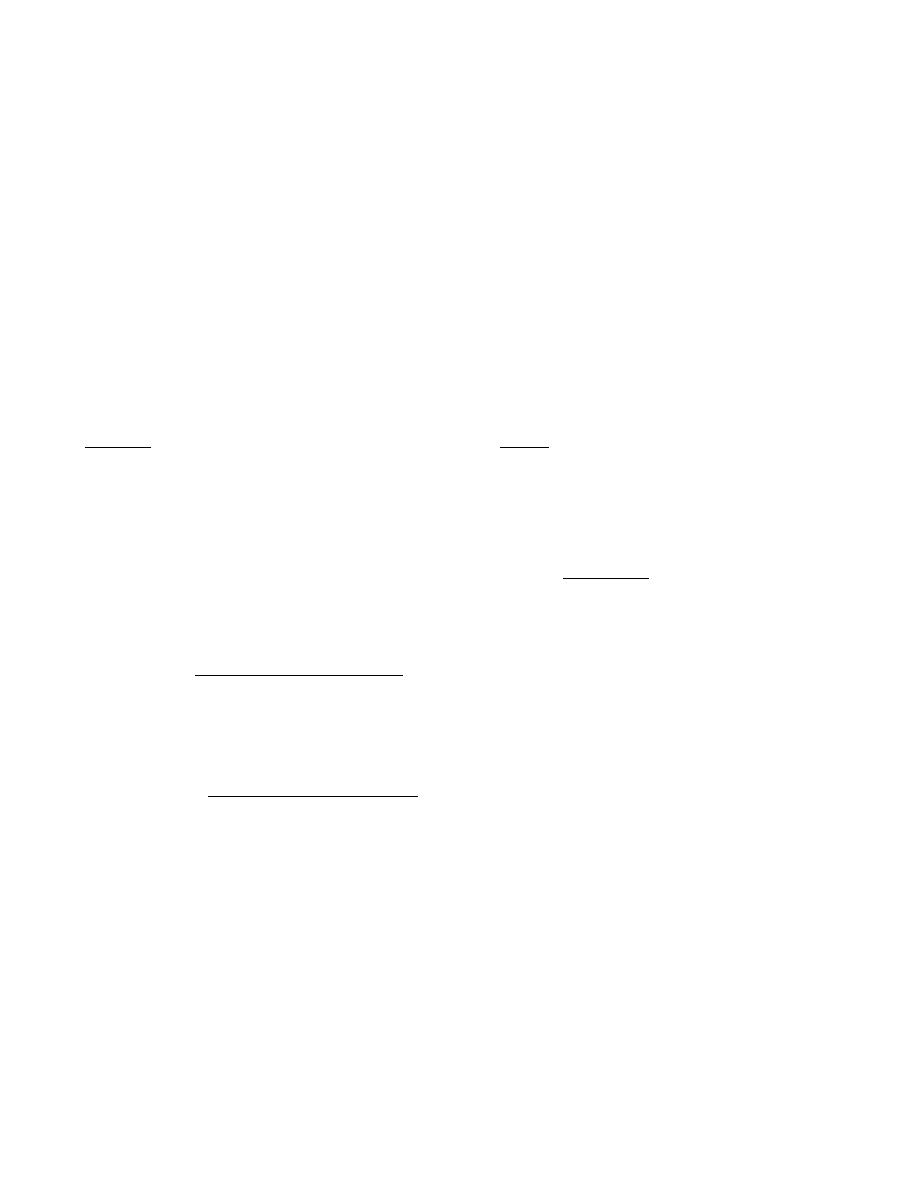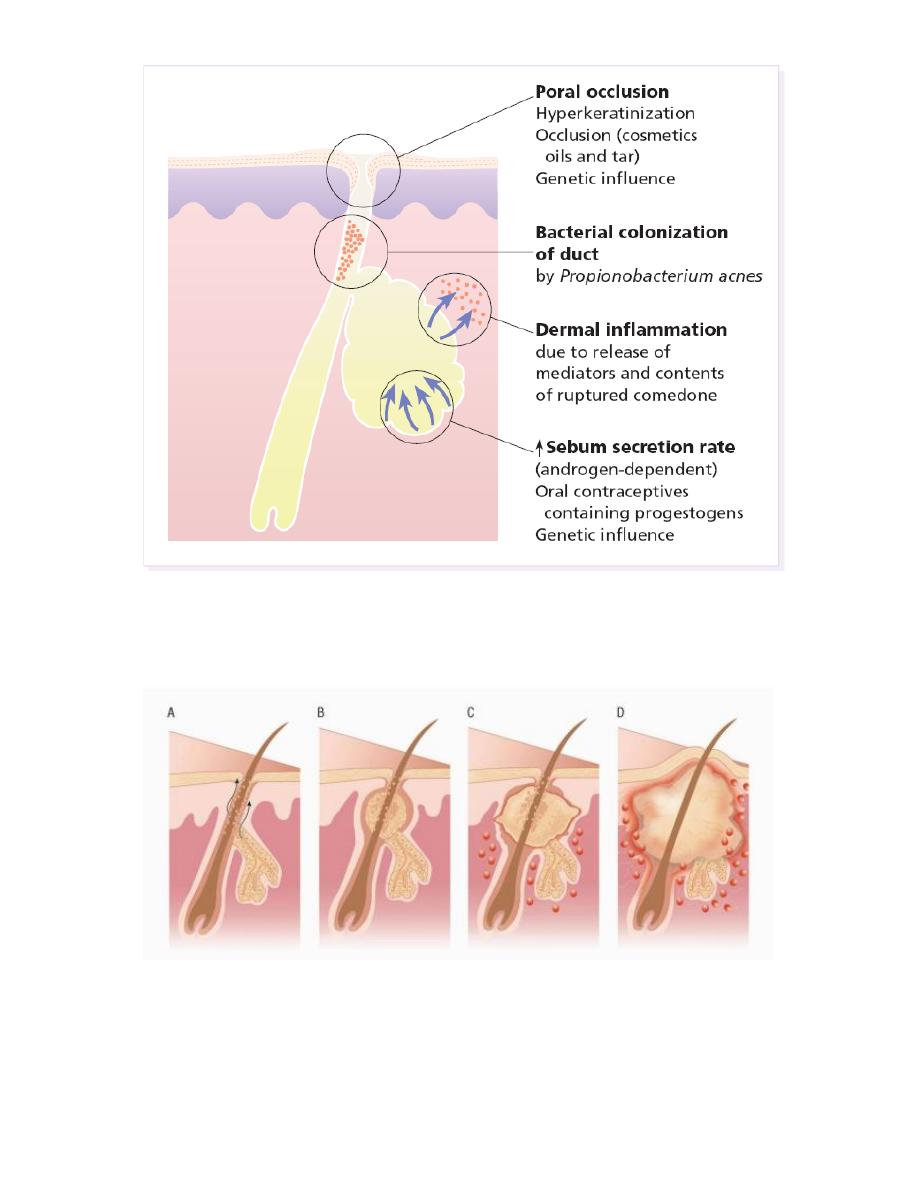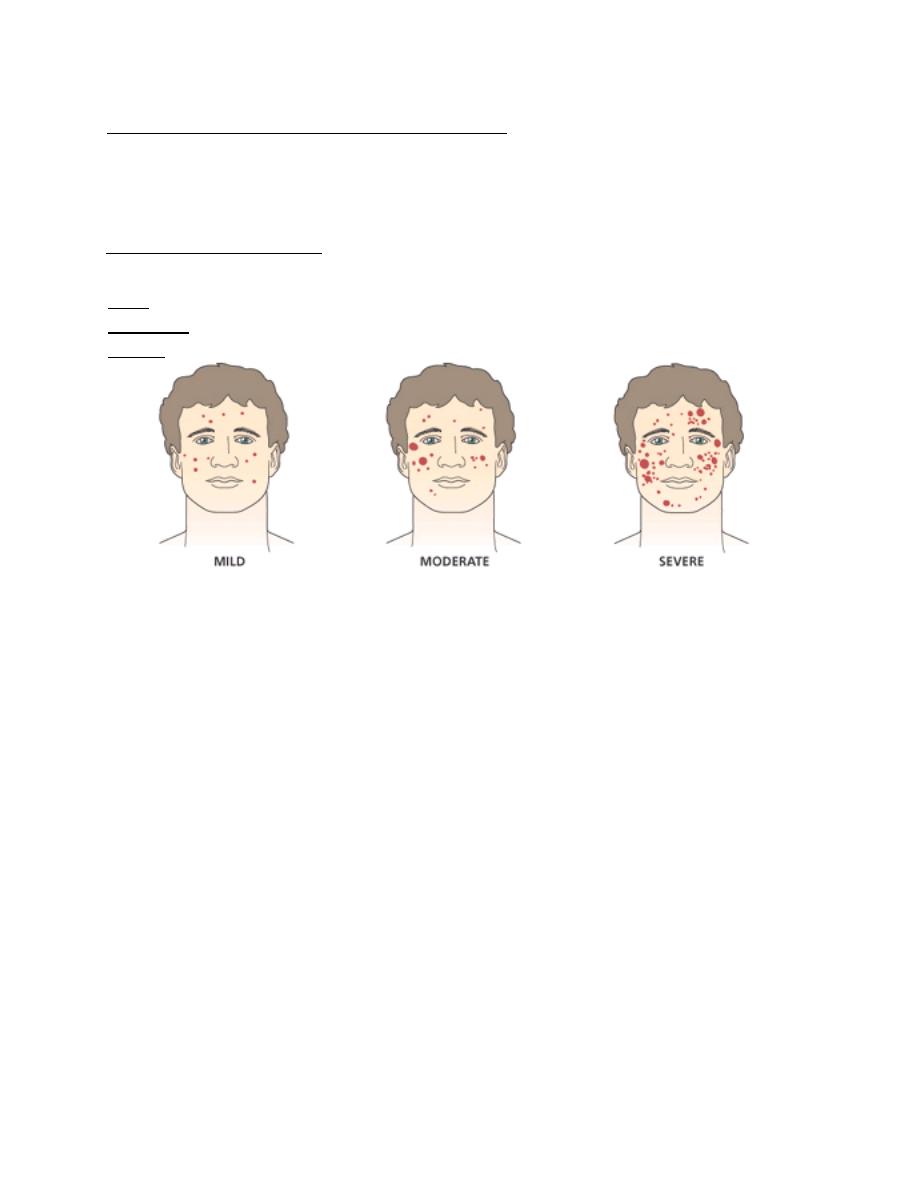
Dermatology Dr. Ahmed Abdulhussein Alhuchami
2018
Acne Vulgaris
Definition:
it is a self-limited disorder of the pilosebaceous unit, that is seen primarily
in adolescents, and appears on skin areas with numerous sebaceous glands.
Epidemiology:
nearly all teenagers have some acne (acne vulgaris).
Only about 15-20 % of affected patients need the help of dermatologist.
Natural History and Course:
● The condition usually starts in adolescence (12-14 years) and frequently resolves by
the mid-twenties, but 5% of women and 1% of men still need treatment in their thirties or
even forties.
● It affects both sexes equally, but the disease tends to be earlier and more persistent in
females, and the most severe form occurs more in males.
Etiology and Pathogenesis:
Many factors combine to cause acne (Figure 1), included:
1- Poral occlusion: both genetic and environmental factors (e.g. some cosmetics) can
cause poral occlusion, results in the formation of the comedons. Follicles then retain
sebum that has an increased concentration of bacteria and free fatty acids. Rupture of
these follicles associated with intense dermal inflammation and tissue damage (Figure 2).
2- Sebum excretion: most sebaceous glands develop embryologically from hair germs
forming the pilosebaceous apparatus. These glands, react to maternal androgens for a
short time after birth, and then lie dormant until puberty, when the sebum output is
increased. Sebaceous glands are largest and most numerous on the face and upper trunk.
Patient with acne usually has seborrhea (excessive production of the sebum for the
patient's age and sex).
3- Bacterial: Propionibacterium acne, a normal skin commensal, is a Gram-positive,
anaerobic bacterium, live deep within hair follicles. Elevated production of sebum or
blockage of the follicle can cause P. acnes bacteria to grow and multiply.
4- Hormonal: in acne, usually the sebaceous glands respond excessively to a normal
level of androgen (increased target organ sensitivity), leading to increased sebum
production.
5- Genetic:
several studies shown that genetic factors influence susceptibility to acne
.
6- Diet:
it plays a minor role in the pathogenesis of acne. It is of value only in certain
situation in which the patient realizes that some types of foods (as CHO, fatty food, and
spices) provoke or exacerbate acne.
7- Emotional stress:
can trigger or exacerbate acne vulgaris.
1

Fig. 1: Factors causing acne.
A-Poral occlusion. B-Comedons. C-Papules & pustules. D-Nodules & cysts.
Fig. 2: Pathogenesis of acne.
2

Presentation:
● Sites: the predilection sites are the face, shoulders, upper chest and back.
● Lesions:
A-The non-inflammatory lesions (comedones): which may be either open (black
comedones) or closed (white comedones). The black comedon appears as a flat or
slightly raised lesion with a central dark colored follicular impaction of keratin and lipid.
The white comedon (the most dangerous), may be difficult to visualize. They appear as
pale or yellowish-white, slightly elevated, small papule.
B-The inflammatory lesions: red papules, pustules, nodules or cysts.
● Severity: acne vulgaris classified according to its severity into:
1- Mild (few papules & pustules with no nodules).
2- Moderate (many papules & pustules with few nodules).
3- Severe (many papules & pustules with many nodules).
Acne Variants:
1- Conglobate: a severe form of acne with abscesses or cysts and intercommunicating
sinuses.
2- Fulminans: is a conglobate acne accompanied by fever, joint pains and a high ESR.
3- Infantile: rare type of acne presents at, or appears soon after birth. It is more common
in males and may last up to 3 years.
4- Excoriated: mostly seen in young girls. Obsessional picking or rubbing leaves
discrete denuded areas.
5- Late onset: occurs mainly in women and is often limited to the chin. Nodular and
cystic lesions predominate. It is stubborn and persistent.
6- Post epilation acne: followed hair epilation, mostly in women, inflammatory in
origin, papulopustular with absence of comedones.
7- Drug-induced (acne medicamentosa): suspicion should be raised when a
papulo-pustular acne, appears suddenly in a non teenager and coincides with taking of a
drug known to cause acneiform eruption {steroids (systemic or topical), androgens and
oral contraceptives, isoniazid, phenytoin, lithium, vit B12, bromides and iodides}.
Complications:
1- Psychological disturbances and depression.
2- Transient macular erythema.
3- Post inflammatory hyperpigmentation: may persist months after resolution of acne.
4- Permanent scarring: There are five types of acne scars, ice pick (narrow, deep and
widest at the surface), rolling (shallow, wide) boxcar (the width is similar at the surface
and base), hypertrophic and keloidal scars.
3

Treatment:
A- General measures:
1- Psychological support: acne frequently has marked psychological effects; even those
with mild acne need sympathy.
2- Treatment of the underlying cause if found.
3- Determine the predominant type of acne lesions (comedonal or inflammatory).
4- Determine the severity of acne; mild acne may need topical treatments only,
Moderate or severe type, need to add systemic treatments.
B- Topical treatment:
1- Regular gentle cleansing: with soap and water should be encouraged, to remove
surface sebum. Antibacterial cleansers are also useful, e.g. chlorhexidine.
2- Benzoyl peroxide (Benoxide gel 2.5-10%): it is antibacterial and anti-inflammatory,
and it is most effective for inflammatory lesions.
3- Local antibiotics: include topical clindamycin, erythromycin and sulfacetamide.
4- Retinoids: vitamin A (retinol) analogues, (including: tretinoin, isotretinoin,
adapalene, and tazarotene) are especially effective against comedones. They normalize
follicular keratinization, and reduce sebum production. Patients should be warned
about skin irritation (start with small amounts and short time) and photosensitivity.
5- Azelaic acid: is bacteriocidal for P. acne, it is also anti-inflammatory and inhibits the
formation of comedones by reducing the proliferation of keratinocytes.
6- Others: as sulphur, zinc sulphate, tea, and peeling agents as alpha hydroxy acids.
7- Combinations.
C- Systemic treatment:
1- Antibiotics: (the antibiotics should be used for at least than 3 months).
● Tetracyclines: ( not given for pregnant or lactating patients).
Tetracycline: an average dosage is 250-500 mg four times daily. It should be taken on
an empty stomach (1 h before meals, or 4 h after food) as the absorption of tetracyclines
is decreased by milk, antacids, calcium, iron and magnesium salts.
Doxycycline: 100 mg tablets or capsules, once or twice daily. It is safe and effective.
The capsule form should be taken after meal with a lot of water (because of gastric
upset).
Minocycline: 50-100 mg once or twice daily. It is more effective, but it is much more
expensive and can cause blue grey pigmentation, especially on the faces and over the
shins.
● Erythromycin: (250-500 mg four times daily) is the next antibiotic of choice but is
preferable for pregnant women and those who might become pregnant. Its major
drawback is the development of resistant P. acne.
● Trimethoprim: as a third-line antibiotic for acne with great potential of side effects,
so
used only in patients with severe acne who do not respond to other antibiotics.
● Ampicillin
and clindamycin: are another alternative.
4

2- Isotretinoin: it is a vitamin A (retinol) analogues, inhibits sebum excretion, the
growth of P. acnes and acute inflammatory processes. The drug is reserved for severe
nodulocystic acne. It is given for 4–6 months, in a dosage of 0.5–1 mg/kg/day.
The most important side-effect is teratogenicity, effective contraception must be taken
for 1 month before starting, throughout treatment, and for 1 month after treatment. Tests
for pregnancy (preferably performed on a blood sample) should be carried out twice
before starting treatment and at each follow-up visits. Other side-effects are dry lips,
mouth, vagina and eyes, peeling of skin, pruritus, paronychia, hair thinning or loss, and
hyperlipidaemia (mainly TG).
3- Hormonal: oral contraceptives (as Diane-35), spironolactone, or cyproterone acetate
used when there is hormonal disturbances and overproduction of androgen (as in
PCOS). Glucocorticoid hormones can be used in very severe acne (as in acne fulminans).
4- Others: zinc, dapsone, and oral vitamin A.
D- Physical treatment:
1- Comedone removal: by a specially shaped tools (comedon extractor).
2- Intralesional injections: of 0.1 mL of triamcinolone acetonide (2.5–10 mg/mL)
hasten the resolution of nodulocystic lesions, but can leave atrophy.
3- Light therapy: lasers and intensive pulse light (IPL), ultraviolet B radiation, and
photodynamic therapy (PDT)
.
E- Treatment of acne scars:
1- Atrophic scars:
(ice pick, rolling, or boxcar scars)
● Chemical peels: using chemical solutions to destroy and exfoliation the epidermis in a
controlled manner, leading to regeneration of new smooth skin .
● Dermabrasion: remove the top layer of the scars and stimulate the growth of new
layers.
● Filler injections: (collagen, hyaluronic acid, and autologous fat transplantation), can
be used to raise atrophic scars to the level of surrounding skin.
● Collagen induction therapy: it is an aesthetic medical procedure that involves
repeatedly puncturing the skin with tiny, sterile needles. Typically, this is done
microneedling device or dermal roller.
● Laser treatment: as CO2 laser, and Er:YAG laser. Can be used for both atrophic and
hypertrophic scars.
2- Hypertrophic scars: (hypertrophic and keloidal scar )
● Semiocclusive ointments (silicone): can be used to speed healing and reduce the
appearance of hypertrophic scars.
●
Intralesional Steroid injections: full strength triamcinolone acetonide injections
into the scar may help flatten and soften the appearance of keloid or hypertrophic scars.
● Radiotherapy: low-dose, superficial radiotherapy is sometimes used to prevent
recurrence of severe keloid and hypertrophic scarring.
● Surgery: by surgical removal of the scars.
5

Rosacea
Definition:
is a chronic inflammatory disorder involving the skin of the nose, forehead,
and cheeks (center of the face), that is characterized by congestion, flushing, and
telangiectasia.
Epidemiology:
the vast majority of cases occur in fair-skinned individuals. It
predominantly affects middle age women (30-50 years), however, children, adolescents,
and young adults may develop rosacea.
Etiology and Pathogenesis:
The exact cause and pathogenesis of rosacea is still unknown, but there are many
etiological and triggering factors, included:
1- Etiological factors:
● Abnormal vascular reactivity.
● Sun damage.
● Abnormalities of dermal connective tissue structure or composition.
● Abnormalities of the Pilosebaceous structure.
● Microbial colonization: commensal organisms as P.acne and Demodex folliculorum.
2- Triggering factors:
Hot or cold temperature, sunlight, wind, hot drinks, spicy foods, alcohol, exercise,
emotions, cosmetics, topical irritants, and medications that promote flushing
(as vasodilators and steroids).
Types and Clinical Features:
1- Papulopustular rosacea: it is the most common type, manifests as persistent, central-
face erythema with papules and pustules that predominate in convex areas of face.
(center of the face).
2- Erythematotelangiectatic rosacea: is characterized by persistent facial erythema and
flushing along with telangiectases, central face edema, burning and stinging, roughness
or scaling, or any combination of these signs and symptoms.
3- Phymatous rosacea: is characterized by patulous follicular orifices, thickened skin,
nodularities, and irregular surface contours in convex areas.
"Phyma" is the Greek word for swelling, or mass. Phyma most often occurs on the nose
of men (rhinophyma), women with rosacea usually do not develop phyma, perhaps for
hormonal reasons.
4- Ocular rosacea: may manifested as blepharitis, conjunctivitis, iritis, scleritis,
hypopyon, and keratitis. In half of ocular rosacea patients, ocular symptoms develop
after skin symptoms.
Complications:
1- Rhinophyma.
2- Ocular complications.
3- Lymphodema.
6

Differential Diagnosis:
A- Acne vulgaris: it differs from rosacea by:
1- More common.
2- Usually appears in adolescence (rosacea usually affect middle age).
3- Male and female are affected equally (rosacea affect women predominantly).
4- Affects fair and dark individuals (the vast majority of rosacea occur in fair-skinned).
5- All the face can be affected (rosacea usually affect the center of the face).
6- Extrafascial involvement are common, as chest and shoulders (very rare in rosacea).
7- Presence of comedones and scars (absent in rosacea).
B- Seborrhoeic dermatitis.
C- Systemic lupus erythematosus.
D- Photodermatitis.
E- Other causes of flushing: as carcinoid syndrome, or menopause.
Treatment:
A- General measures:
The triggering factors must be identified and avoided.
Daily application of broad spectrum sunscreens, hat use, and avoidance of mid-day sun.
B- Local treatment:
1- Food and Drug Administration (FDA) approved: include: azelaic acid,
metronidazole, sodium sulfacetamide and sulfur.
2- Not FDA approved: include benzoyl peroxide, clindamycin, erythromycin,
tacrolimus, and topical retinoids.
● Recently Brimonidine Topical Gel ( The alpha2-adrenergic agonist) yields significant
improvement in the facial redness of rosacea.
3- Others: “Manual” therapy should also be considered adjunctively in rosacea patients.
Facial massage is performed in the direction of the lymphatic flow. This can help to
mobilize edema and speeds clearance of dermal inflammation.
C- Systemic treatment:
1- Doxycycline: used for 2-4 months.
2- Isotretinoin: Low-dose isotretinoin (less than 0.5 mg/kg/day) can be effective and is
better tolerated in rosacea patients.
3- Others: erythromycine, metronidazole, anti-androgenic agents (oral contraceptives,
spironolactone, and cyproterone acetate), β blockers (as carvedilol), and clonidine.
D- Light therapy:
Laser (as pulse dye laser) and intense pulsed light (IPL) therapy are useful alternatives
to oral therapies; they may be used adjunctively with topical and oral rosacea regimens
for faster and more complete symptom resolution.
"Best Regards"
7
